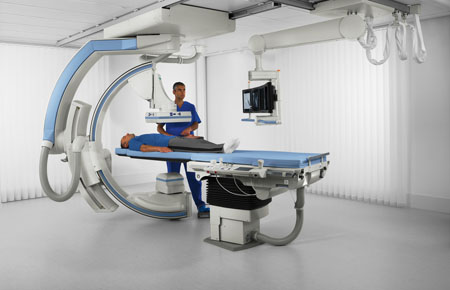Introduction
Fluoroscopy equipment has revolutionized the field of medical imaging, allowing healthcare professionals to observe dynamic internal structures and functions in real-time. This blog post aims to provide a thorough understanding of fluoroscopy, its applications, and how it has evolved over the years.
What Is Fluoroscopy?
Fluoroscopy is a medical imaging technique that uses X-rays to obtain real-time moving images of the inside of a patient’s body. Unlike traditional X-rays, which capture static images, fluoroscopy offers dynamic visualization, making it an invaluable tool for a wide range of medical procedures.
The History of Fluoroscopy
Fluoroscopy has a rich history that dates back to the late 19th century. Wilhelm Conrad Roentgen’s discovery of X-rays in 1895 laid the foundation for this groundbreaking imaging technique. The first practical fluoroscope was developed by Thomas Edison, which marked the beginning of its use in the medical field.
Applications of Fluoroscopy
Fluoroscopy is widely used in various medical specialties, and its applications continue to expand. Some of the key areas where fluoroscopy equipment plays a crucial role include:
- Radiology
Fluoroscopy is commonly used in radiology to examine the gastrointestinal tract, urinary system, and cardiovascular system. It helps diagnose conditions like blockages, tumors, and malformations. - Orthopedics
Orthopedic surgeons use fluoroscopy to guide them during procedures such as bone fracture reductions and joint injections. Real-time imaging allows for precise placement of implants and instruments. - Cardiology
In cardiology, fluoroscopy is indispensable for performing procedures like angiography and cardiac catheterization. It helps visualize blood vessels and the heart’s chambers to diagnose and treat heart conditions. - Gastroenterology
Gastroenterologists use fluoroscopy to examine the esophagus, stomach, and intestines. This aids in diagnosing conditions such as ulcers, reflux, and gastrointestinal bleeding. - Pain Management
Fluoroscopy-guided interventions are common in pain management. It allows for accurate injections of pain-relief medications into specific areas, such as the spine or joints. - Surgery
During surgery, fluoroscopy can be employed to confirm the correct positioning of instruments or implants. This minimizes the risk of complications and enhances surgical precision.
Advantages of Fluoroscopy
Fluoroscopy offers several advantages in the field of medical imaging:
- Real-time Visualization
One of the primary benefits of fluoroscopy is the ability to view internal structures in real-time. This is invaluable for guiding procedures and ensuring accuracy. - Minimally Invasive
Many fluoroscopy-guided procedures are minimally invasive, reducing the need for open surgery and resulting in shorter recovery times and less scarring. - Improved Diagnostic Accuracy
The dynamic nature of fluoroscopy allows for better diagnosis and treatment planning, especially in complex cases. - Reduced Radiation Exposure
Modern fluoroscopy equipment is designed with safety in mind, minimizing radiation exposure to both patients and medical personnel.
Evolving Technology: Digital Fluoroscopy
The field of medical imaging is constantly advancing, and fluoroscopy is no exception. Digital fluoroscopy has become the standard, offering numerous benefits over traditional analog systems.
Digital fluoroscopy provides:
- Enhanced Image Quality
Digital technology produces higher-resolution images, allowing for more precise diagnostics and intervention. - Lower Radiation Dose
Advanced image processing techniques reduce the amount of radiation required to obtain high-quality images, prioritizing patient safety. - Image Storage and Sharing
Digital fluoroscopy systems allow for easy storage, retrieval, and sharing of patient images, promoting seamless collaboration among healthcare providers. - Post-Processing Capabilities
Digital images can be manipulated and enhanced post-procedure, aiding in further analysis and documentation.
Future Trends in Fluoroscopy
As technology continues to evolve, the future of fluoroscopy is filled with exciting possibilities. Some trends to watch out for include:
- Artificial Intelligence (AI) Integration
AI can assist in real-time image analysis, enabling quicker and more accurate diagnosis during fluoroscopy procedures. - 3D Imaging
Advancements in 3D fluoroscopy will provide even more detailed views of anatomical structures, enhancing diagnostic capabilities. - Virtual Reality (VR) Integration
VR technology may be incorporated into fluoroscopy systems, allowing surgeons to visualize and interact with 3D reconstructions during procedures. - Improved Workflow Integration
Seamless integration with electronic health records (EHR) and other healthcare systems will enhance the overall efficiency of fluoroscopy procedures.
Conclusion
Fluoroscopy equipment has come a long way since its inception, and its impact on modern medicine is immeasurable. From its historical roots to its current digital form, fluoroscopy continues to play a crucial role in diagnosing and treating a wide range of medical conditions. With ongoing technological advancements, the future of fluoroscopy is promising, offering even more precise and efficient healthcare solutions.
Medical professionals and researchers must remain vigilant in exploring new possibilities, harnessing the power of fluoroscopy to improve patient care and enhance our understanding of the human body. As the field of medical imaging continues to evolve, fluoroscopy stands as a testament to the remarkable progress that has been made in the pursuit of better healthcare for all.



